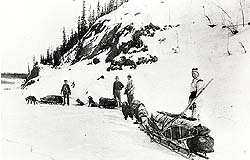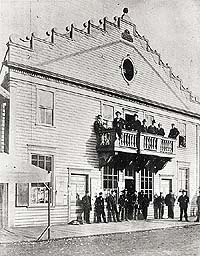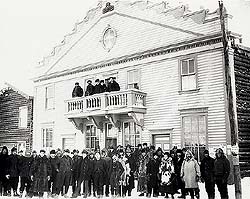 |

 
|
 |
INTRODUCTION
With the advent of the Klondike gold rush in the late 1890s, Yukon was invaded by thousands of people hoping to find gold and become instantly wealthy. In 1897, approximately 1,500 people lived in Dawson; by the summer of 1898, the population had grown to around 30,000.1 It became the largest Canadian town west of Winnipeg. Throughout 1898, steamers arrived in Seattle from the Klondike carrying tons of gold and sent back hundreds of dreamers searching for gold that, in many cases, was never found.2
 |

Fred Camsell, Charles Camsell, D.W. Wright and A.N. Pelly in the Liard River Canyon, En Route to Klondike, Yukon, January 1898
© Public domain
National Library and National Archives
of Canada, C-020382
Geologist Charles Camsell (1876–1958) headed the Canadian Geological Service before being named Deputy Minister of Mines in 1920. He also played a major role in the exploration of mining resources. From the late 1840s, the Liard River was used as a route for transporting the mail. |
Many gold seekers arrived in the Klondike with little idea of what lay ahead. They had not anticipated being almost completely isolated from civilization and struggling to obtain the bare necessities required to survive the bitterly cold winters. The barren land was unforgiving; many were forced to turn back empty-handed. For those who did remain in the Yukon, thousands of miles from home, communication with other parts of the country was a lifeline. The briefest note, a small gift or even a postcard from a family member or friend could make a gold seeker's spirits soar.
 |

Employees of Dawson's First
Post Office, Yukon
© Public domain
National Library and National Archives
of Canada, C-018622
The post office opened its doors on
September 1, 1897. Frank Harper, a North-West Mounted Police inspector, was the first postmaster until October 1898. Isaac J. Hartman took over on November 1 and held the position until he retired in February 1913. |
 |

Dawson Post Office, Yukon, ca. 1898–1910
© Public domain
National Library and National Archives
of Canada, PA-013324
This photo, taken in winter, shows the employees at the Dawson post office and some curious onlookers. Until a land route was opened in 1902, mail service could be paralysed for several months, in spring and fall, when the ice halted travel but was not yet solid enough to traverse.
|

|
 |